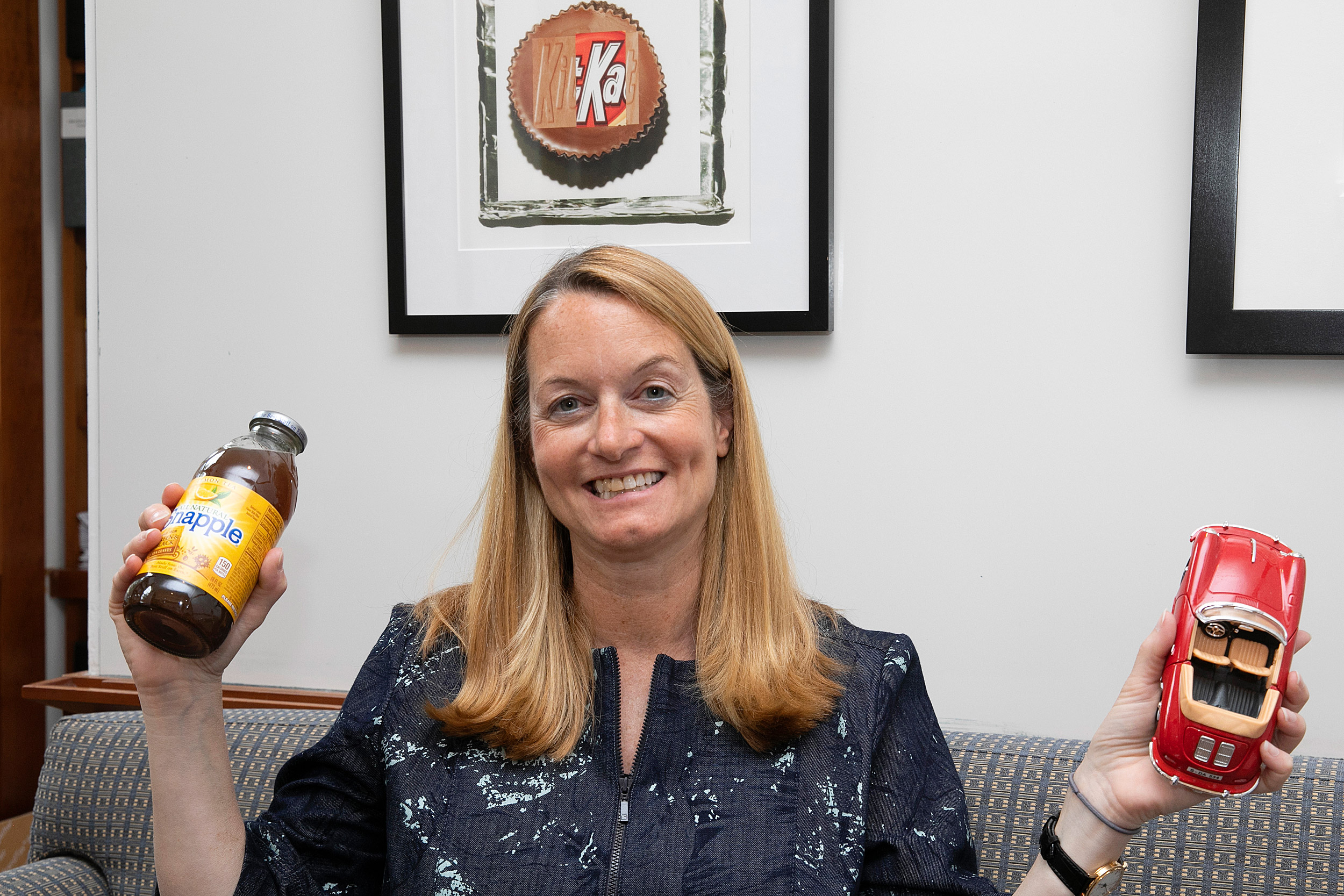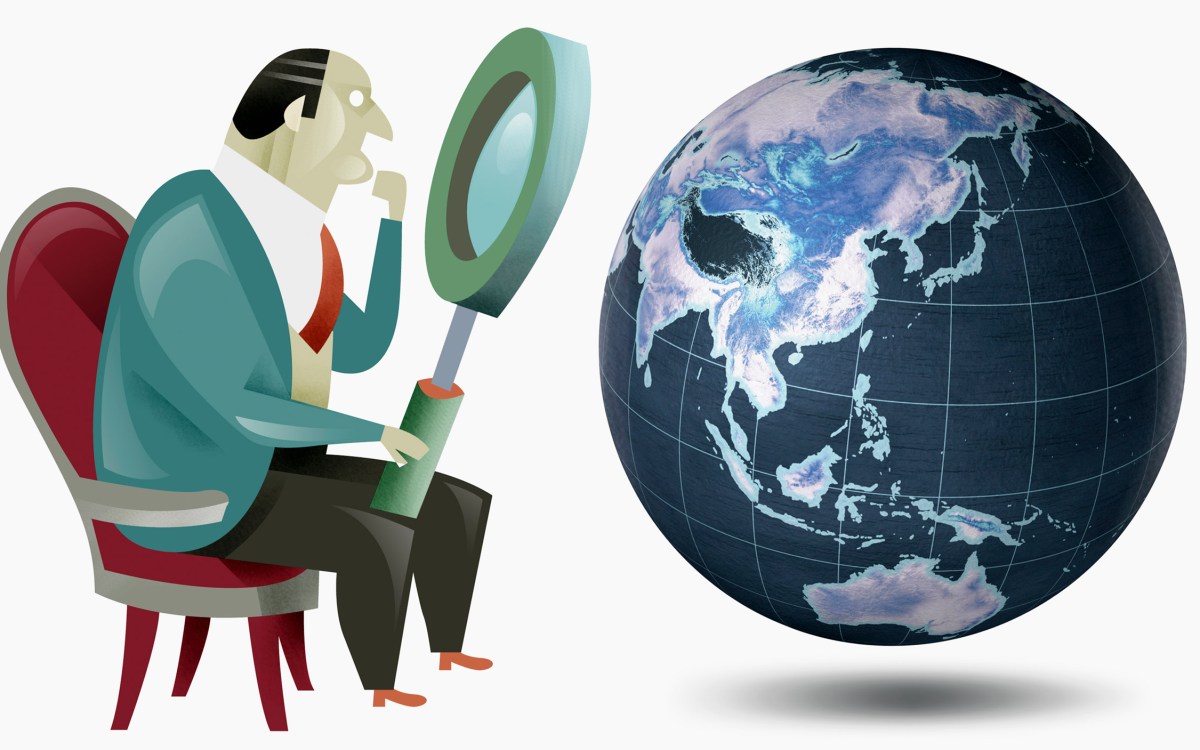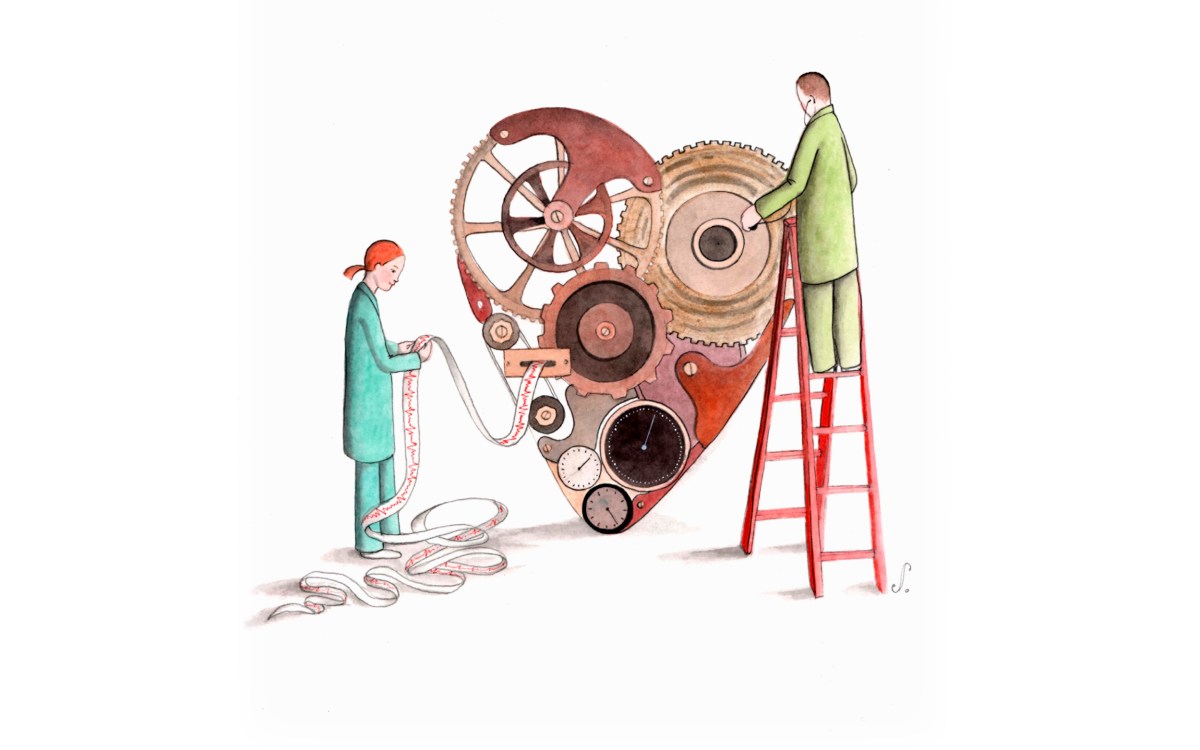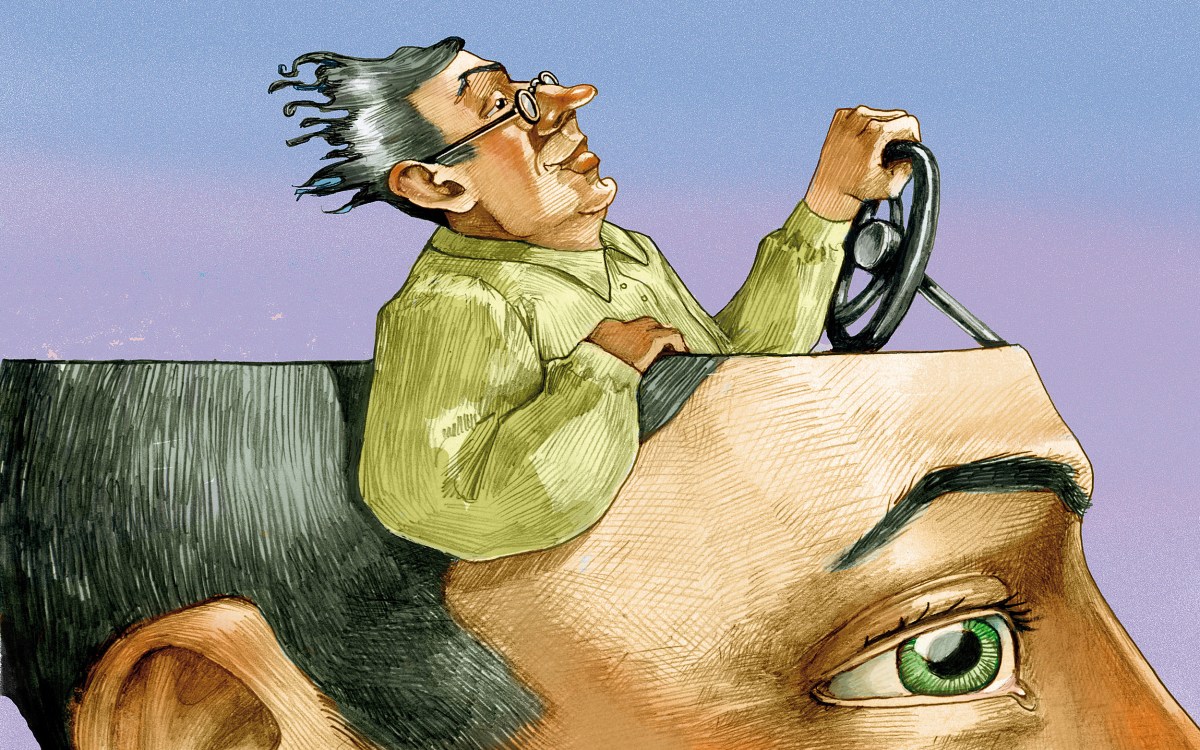
Jill Avery teaches “Creating Brand Value,” an M.B.A. course for investors, entrepreneurs, and marketers.
Jon Chase/Harvard Staff Photographer
The story of how you came to buy that car
Marketers target our values, fears, and aspirations using narrative techniques
They routinely ask some of life’s deepest questions: Who are you? What do you care about? What are your goals in life? What do you struggle with? What do you love and hate?
But these are not psychiatrists or spiritual advisers; they’re marketers probing consumers to figure out why we buy. Whether it’s sleek sports cars, laundry detergents, or cellphones, mapping the views and yearnings of potential buyers helps these specialists construct ad campaigns and brand identities. Though people say they buy for rational reasons like effectiveness or price, the truth is that they often make purchases for more complex reasons, so marketers dig deep with their pitches, targeting our values, fears, and aspirations. And these days the preferred delivery vehicle is often a story.
“It always starts with understanding people — fleshing out a full portrait of who a potential customer might be for this product. Because doing laundry is never just about doing laundry. It’s about being a mom or dad and taking care of my family and presenting a clean front to the world,” said Jill Avery, a senior lecturer of business administration at Harvard Business School who studies brand management and teaches “Creating Brand Value,” an M.B.A. course for investors, entrepreneurs, and marketers.
Branding used to be a shorthand way to convey reputation to potential buyers who prized claims of performance (“gets whites whiter”) and expert opinion (“four out of five dentists recommend this chewing gum”) over all else. But since the 1960s, consumers have become tougher to persuade with rational sales pitches.
“Whereas prior to this, ‘Why should I buy?’ was all about function, in this era, ‘Why should I buy?’ has become wrapped up in who my identity is or who I want to be or what kind of lifestyle I aspire to,” said Avery. “In many product categories, you’re buying into the brand much more than you’re buying into the product.”
Some of the world’s most famous brands, like Apple, Nike, and Coca-Cola, have successfully trained consumers to associate their companies with emotional concepts — rebelling, winning, and belonging, respectively — rather than merely the goods they sell.
“People want to believe that they’re not swayed by brands,” said Avery. “They are.”
12 main character archetypes found in brand stories
Image gallery

The Caregiver Most fulfilled when they can make a difference for someone else. Naturally compassionate, nurturing, and dedicated, they enjoy demonstrating their supportiveness and can motivate others to provide better service or care. They’re usually excited and challenged by responding to needs.

The Regular Guy/Gal Most fulfilled by helping others belong and fit in to the group. Naturally empathetic, unpretentious, and resilient, they often demonstrate their common touch and can motivate others to try hard to do their best. They’re usually excited and challenged when everyone needs to pitch in and solve a problem.

The Warrior Most fulfilled when they can rise to and overcome a challenge. Naturally determined, achievement-oriented, and focused, they enjoy demonstrating a winning attitude and often can motivate others to achieve their goals. They’re usually excited and challenged by the opportunity to prevail against the odds.

The Innocent Most fulfilled when their lives are based on their deeply held values and beliefs. Naturally idealistic, optimistic, and hopeful, they often demonstrate perseverance in the face of obstacles and motivate others to trust that everything will turn out well in the end. They’re most excited and challenged by opportunities to put their personal values into action.

The Creator Most fulfilled by seeing new ideas take shape. Naturally expressive, original, and imaginative, they enjoy demonstrating their inventiveness and often are to motivate creative thinking in others. They’re usually excited and challenged by opportunities to express themselves or advance new ideas.

The Lover Most fulfilled by building relationships. Naturally appreciative, passionate, and committed, they enjoy creating consensus and motivating others to see and utilize their own special gifts. They’re usually excited and challenged by opportunities to enjoy the richness and fullness of life.

The Outlaw Most fulfilled when they can change something that they feel needs to be changed. Often unconventional thinkers who can develop new, cutting-edge approaches, they enjoy challenging the status quo and motivating others to think differently. They’re usually excited and challenged when they can take on tried-and-true methods or ways.

The Explorer Most fulfilled when they can seek out new approaches and perspectives. Naturally independent, authentic, and curious, they’re able to follow unique paths and motivate others to explore uncharted territory. They’re usually excited and challenged by the opportunity to blaze a new trail.

The Ruler Most fulfilled when they can demonstrate leadership, orchestrate complex situations, and/or use their influence to make things work better. Naturally confident, competent, and responsible, they enjoy demonstrating their savvy and motivating others to maintain high standards. They’re usually excited and challenged by opportunities to take charge of a situation.

The Jester Most fulfilled when they can use their ingenuity and wit. Naturally playful, spontaneous, and humorous, they enjoy light-hearted truth-telling and can motivate others to see the value of fun. They’re usually exited and challenged by opportunities to lighten up stressful situations.

The Magician Most fulfilled when they can see a vision realized. Naturally intuitive, insightful, and inspiring, they’re able to perceive and appreciate multiple perspectives and motivate others to believe that anything is possible. They’re usually excited and challenged in times of great transformation and turmoil.

The Sage Most fulfilled by finding the answers to the great questions. Naturally intelligent, knowledgeable, and reflective, they demonstrate the value of thinking things through and motivate others to seek the truth. They’re usually excited and challenged by situations and problems that need to be better understood.
In a recent HBS Technical Note on brand storytelling, Jill Avery wrote that effective narratives include compelling characters, citing 12 common examples used in marketing. Click to read more about each type. Source: “The Hero and the Outlaw,” Margaret Mark and Carol Pearson; “Brand Storytelling,” Jill Avery
As firms attach ever-more-sophisticated meanings to their brands, marketing professionals now reach for the tools and techniques used by authors and filmmakers to leverage the human fascination with stories in order to lure audiences in a way that obvious sales pitches cannot.
Stories “generate higher levels of engagement, learning, persuasion, and inspiration for action” than other forms of communication, making them a “superior” vehicle to reach and affect consumer behavior, Avery wrote in a recent HBS Technical Note on brand storytelling. That’s important, because in “today’s world, where attention is scarce and consumers are bombarded with thousands of brand messages each day, brands that are able to tell compelling stories can break through the clutter and create engagement.”
Using humor, romance, sex, or even irony, effective narratives include compelling characters, a conflict and plot that feel fresh yet familiar, and a clear message that comes across as transparent and authentic, not manipulative, she said.
Some of the world’s most famous brands, like Apple, Nike, and Coca-Cola, have successfully trained consumers to associate their companies with emotional concepts — rebelling, winning, and belonging, respectively — rather than merely the goods they sell.
Brand stories are told in many ways, such as on Twitter, through a retail store experience, through packaging and logos, or via a social media influencer’s posts on Instagram or Facebook. Figuring out what will grab would-be buyers is a dicey, complicated task for marketing professionals, for as times and people change, so do the stories that resonate.
“What are we anxious about right now? If we can figure that out as marketers, then we can deliver stories that … help release that anxiety through consumption,” she said.
These days, politics and our deep national divisions are sources of angst for many. But where Baby Boomers once sought to “fight the power” and “change the world” through protests and boycotts, Avery says today “we often show our political activism through purchase.” Instead of just avoiding a brand that offends, consumers now deliberately “buycott” — buy one brand over others — to show support for a company’s political stance.
Nike’s 2018 “Just Do It” ad campaign featured former NFL quarterback and racial-justice activist Colin Kaepernick (who is himself, as are all major celebrities, a brand) and was a dramatic example of the kind of political storytelling popular today. Though it was created for one of the biggest corporate brands in the world, the campaign’s implicit message was that you should buy Nike products if “you support the little guy, you support taking a stand, you support the struggle, you support the people who stand apart from the mainstream,” said Avery, who wrote a case study on the campaign.
What works in much of the country today are narratives that connect brands to social causes, showcase a brand’s ethos or purpose in the world, highlight underdogs or entrepreneurs as heroes, or demonstrate companies making a difference, an approach pioneered decades ago by ice-cream maker Ben & Jerry’s.
“We’re not just selling ice cream; we’re changing social consciousness,” said Avery of the company’s unspoken message to consumers.
Since the 1990s, as trust in big institutions started to wane, Avery says brand stories that highlight notions of “authenticity” have been very effective across many sectors, ranging from trends in craft beer, artisanal food, and farm-to-table restaurants to Airbnb-style tourism and Etsy-type goods. Many firms work hard trying to manufacture authenticity, the case study found, using enticing Instagram stories or posts by top social media influencers to drive sales rather than straight-up advertising.
Newer brands that present themselves as earnest upstarts overcoming the odds are especially popular now. Underdog narratives remain a powerful and enduring part of consumers’ experience, said Avery, who studied this phenomenon.
“What we found is that most people perceive themselves as underdogs, even people that rationally shouldn’t perceive themselves as underdogs,” like many of the HBS students who participated in a study and thought they, too, were underdogs.
“So if I feel like I’m an underdog, I’m going to be attracted to underdog brands,” said Avery.
What doesn’t sell like it used to? Surprisingly, sex. Campaigns built on “blatant sexuality,” even when it’s integral to a brand, such as lingerie retailer Victoria’s Secret, are facing tougher times, said Avery. In the #MeToo era, advertisers approach gender, sex, and romance far differently than in years past. Many more companies embrace LGBTQ consumers and interracial couples and have moved away from depicting men and women in stereotypical gender roles, she said.
Prestige and luxury are still important to consumers, but it’s less about overt displays of wealth and luxury than it was just a decade ago when company logos were ubiquitous and bragging about paying top dollar was a thing.
“Today, people are looking more for a horizontal differentiation, so being different, rather than being ‘better,’” Avery said. “It’s about being unique, finding the thing that nobody else knew about, being an expert in diverse experiences … that’s giving us identity value versus the conspicuous consumption … of the past.”









